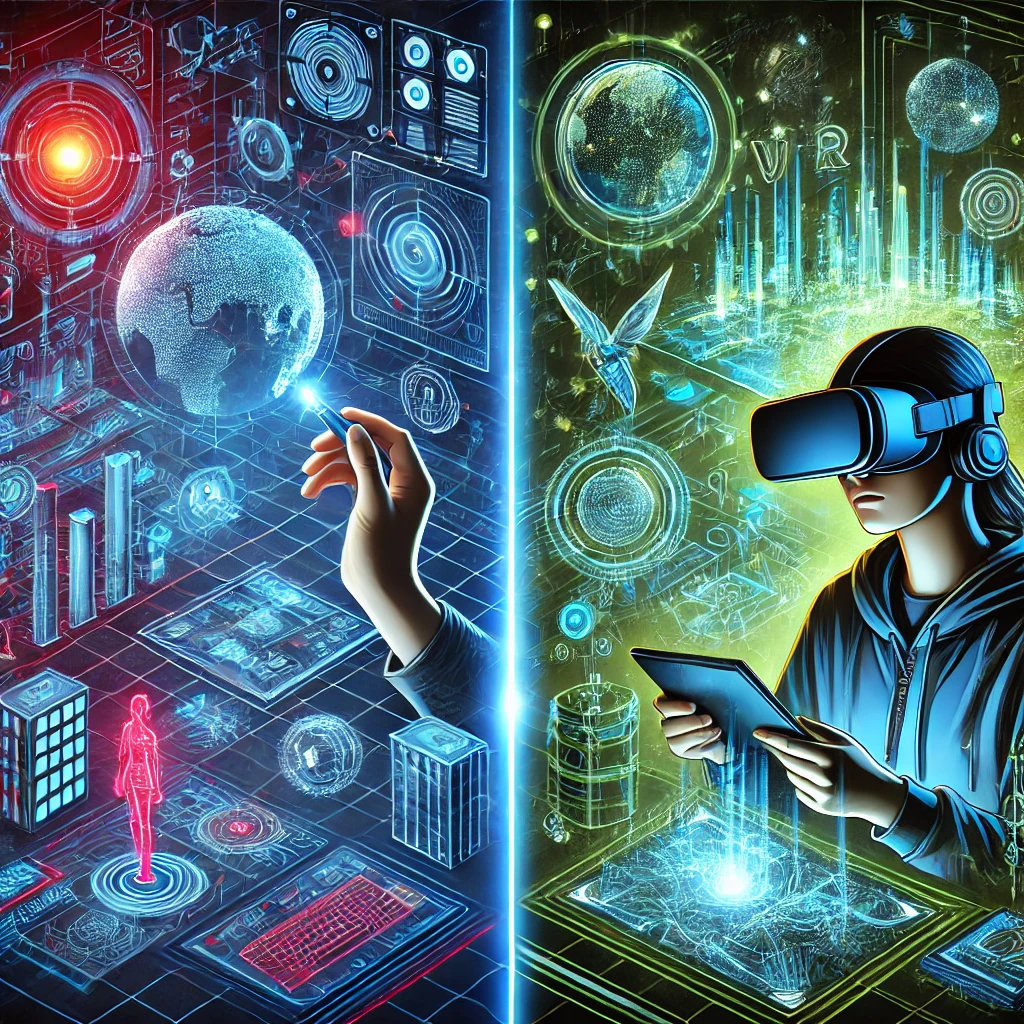Introduction to AR and VR
Augmented Reality (AR) and Virtual Reality (VR) are two of the most exciting technological advancements of the 21st century, transforming how we interact with the digital world. While both technologies enhance our perception of reality, they do so in fundamentally different ways. As AR and VR continue to evolve, they are finding applications in gaming, education, healthcare, and beyond. In this article, we’ll explore the key differences between AR and VR, their current uses, and where they are headed in the future.
What Is Augmented Reality (AR)?
Augmented Reality (AR) enhances the real world by overlaying digital content onto it. This digital layer can include text, images, animations, or 3D models, which can be viewed through AR-enabled devices like smartphones, tablets, or AR glasses. AR technology does not replace the real world but rather adds to it, creating an interactive and immersive experience.
Key Features of AR:
- Enhances the Real World: AR integrates digital elements into the user’s real-world environment.
- Uses Existing Devices: Most AR experiences require only a smartphone or tablet, making it more accessible than VR.
- Interactive in Real-Time: Users can engage with AR content while still interacting with their surroundings.
- Applications Across Various Industries: AR is used in retail, healthcare, gaming, and education, among other fields.
Popular Examples of AR:
- Pokemon GO: The mobile game that overlays digital creatures onto real-world locations.
- IKEA Place App: Allows users to visualize furniture in their home before purchasing.
- Google Lens: Uses AR to provide real-time information about objects seen through a phone’s camera.
- Snapchat & Instagram Filters: Enhance photos and videos with interactive digital effects.
What Is Virtual Reality (VR)?
Virtual Reality (VR) is a fully immersive digital experience that replaces the real world with a computer-generated environment. VR requires the use of specialized headsets, such as the Oculus Rift, HTC Vive, or PlayStation VR, which transport users into a completely virtual space. Unlike AR, VR does not incorporate real-world elements; instead, it creates a new reality that users can explore and interact with.
Key Features of VR:
- Fully Immersive: Users are placed in a completely digital environment, disconnecting from the real world.
- Requires VR Headsets: VR experiences require specialized hardware for a truly immersive effect.
- Engages Multiple Senses: VR can incorporate sight, sound, and even touch for an enhanced experience.
- Ideal for Simulations and Training: Used extensively in education, healthcare, and military applications.
Popular Examples of VR:
- Oculus Quest 2: A standalone VR headset offering gaming and social experiences.
- Google Earth VR: Allows users to explore the world from a fully immersive perspective.
- VR Training for Pilots & Surgeons: Helps professionals practice skills in a risk-free environment.
- Beat Saber: A rhythm-based VR game where players use motion controllers to slash through beats.
AR vs. VR: Key Differences
While AR and VR share some similarities, they differ in fundamental ways:
| Feature | Augmented Reality (AR) | Virtual Reality (VR) |
|---|---|---|
| Environment | Enhances real-world surroundings | Replaces reality with a digital world |
| Hardware | Uses smartphones, tablets, or AR glasses | Requires VR headsets and controllers |
| Immersion | Partial immersion; user remains aware of the real world | Full immersion; user is completely inside the virtual environment |
| Interactivity | Allows interaction with real and digital objects | Interaction occurs within the virtual space |
| Use Cases | Retail, navigation, healthcare, social media | Gaming, simulations, virtual tourism, training |
The Future of AR and VR
Both AR and VR are evolving rapidly, with major advancements expected in the coming years. Here’s what the future holds for each technology:
The Future of AR
- AR Glasses Becoming Mainstream: Companies like Apple, Google, and Meta are developing AR glasses that will replace smartphones as the primary digital interface.
- AI Integration: Artificial intelligence will enhance AR experiences, making them more intuitive and personalized.
- Improved Spatial Mapping: Future AR applications will feature better real-world mapping for seamless interactions.
- Wider Industry Adoption: AR will continue expanding into healthcare (AR-assisted surgeries), education (interactive learning), and retail (virtual try-ons).
The Future of VR
- More Affordable VR Headsets: Prices will decrease as technology advances, making VR more accessible to the general public.
- Metaverse Development: Companies are working towards creating fully immersive virtual worlds where users can socialize, work, and play.
- Enhanced Haptic Feedback: Future VR systems will include better tactile feedback, allowing users to “feel” virtual objects.
- Wider Business Adoption: Beyond gaming, VR will be used in training, remote work, and even virtual tourism.
Conclusion: The Best of Both Worlds
AR and VR are two sides of the same coin, each offering unique benefits depending on the use case. AR enhances our daily lives by overlaying digital elements onto reality, making it ideal for practical applications. VR, on the other hand, transports users into entirely new worlds, offering deep immersion perfect for gaming, training, and simulations. As both technologies continue to develop, we can expect to see even more innovative applications that bridge the gap between the physical and digital worlds. Whether through AR’s real-world enhancements or VR’s immersive experiences, the future of interactive technology is brighter than ever.
